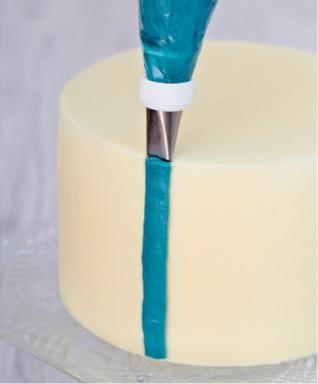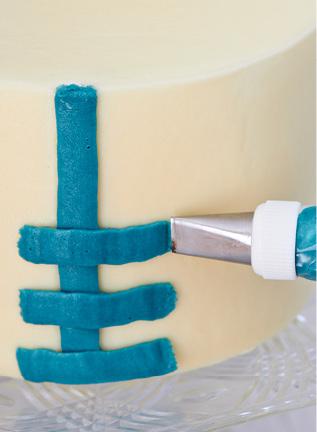The Contemporary Buttercream Bible (12 page)
Read The Contemporary Buttercream Bible Online
Authors: Christina Ong Valeri Valeriano

Sunflower and Leaves in Piping Flowers) and
131

adding light green foliage (see Ruffles in Piping
Texture and Patterns) on the top and sides.
Traditional Basketweave
1 Mark a vertical line using a smooth edge cake
scraper on the cake side to ensure your vertical
basketweave lines are straight. You can judge the
rest from this first line (A).
A
2 Using Wilton nozzle number 45, or 48, with the
smooth side pointing upwards, pipe a vertical line.
132

You can start at either the top or the bottom,
whichever you find easier (B).
B
3 Pipe about 4–5cm (11⁄2–2in) short horizontal lines
across the vertical line starting from either the top or bottom of the cake. The spacing between the
lines should be the same as the width of the nozzle’s tip opening (C).
133

C
Tip
It can be tricky to pipe straight lines, especially
on the side of a cake. We suggest you practise
piping on a cake board held upright. Another
effective tip is to drag the piping bag quickly –
this makes the lines less wiggly.
4 Pipe another vertical line that overlaps the
horizontal lines. The spacing between the vertical
lines should be less than 2.5cm (1in). Pipe another
134

sets of horizontal lines and make sure each line is
slightly buried under the first vertical line (D).
D
5 Repeat the process of piping vertical and
horizontal lines until you cover the whole cake (E).
135

E
Tip
To create a different effect while using the
same basketweave technique, try using a
simple medium round nozzle or just cut the tip
off a piping bag to create a medium-size hole.
Or use two or more different shades of the
colour you have chosen.
Tip
Make sure that you pipe the ‘weaves’ before
the crumb coat has crusted and with a little
136
pressure so they stick to your cake. The
horizontal weaves should seem like they are
coming from underneath the vertical weaves to
make the basketweave look more realistic.
137

To create this cake…
• 15 × 15cm (6 × 6in) round cake
• 950g–1.25kg (2lb 2oz–2lb 12oz) buttercream
138
• Paste colours: turquoise (Sugarflair Turquoise),
dark pink (Sugarflair Claret), light green (Sugarflair Bittermelon)
• Piping bags
• Basketweave nozzle (Wilton 48) or plain
basketweave nozzle (Wilton 45) and small petal
nozzle (Wilton 104)
• Side scraper or ruler
• Cake stand or covered cake board
Cover the cake (see Covering Cakes in Buttercream
Basics), and place on a covered cake board or stand.
Colour 400–500g (14oz–1lb 2oz) of buttercream
turquoise, and 100–150g (31⁄ –51
2
⁄2oz) a darker shade
of turquoise. Pipe the basketweave pattern as
described in the tutorial. Pipe a border using the
crochet technique (see Crochet in Textile Effects)
on the top edge of the cake with the darker shade of
turquoise and a piping bag with the tip snipped off.
Finish by piping camellias around the base using
400–500g (14oz–1lb 2oz) dark pink for the petals
and 50–100g (13⁄ –31
4
⁄2oz) light green for the centres
(see Camellia and Hydrangea in Piping Flowers).
139

E- and C-scrolls
This is one of the easiest techniques to master, yet it can produce a really rather elegant design when
nicely coordinated, the lavish swirls create a rich
and elaborate texture. The two types are named
after the letter of the alphabet that they resemble.
We like to combine the e- and c-scrolls to achieve a
Victorian look on a cake.
1 Using a ruler, mark 6.5–7.5cm (21⁄2 –3in) wide
diagonal bands on all sides of the cake (A).
A
140

2 Using a star nozzle (Wilton 16), pipe a reverse
c-scroll by holding the piping bag straight on to the cake with the curve tip touching the surface (B).
Squeeze with even pressure, and move a little to the
left before circling up and around to the right, down and then and up, creating a backwards letter ‘c’.
B
3 Pipe another c-scroll from the same starting point
as the first, but this time do the opposite (C). The
piping bag goes around to the left then up until it
creates a ‘c’.
141

